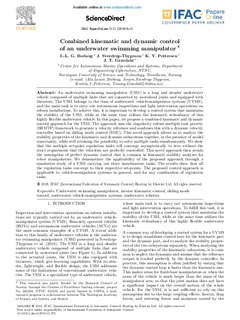| dc.contributor.author | Borlaug, Ida-Louise Garmann | |
| dc.contributor.author | Sverdrup-Thygeson, Jørgen | |
| dc.contributor.author | Pettersen, Kristin Ytterstad | |
| dc.contributor.author | Gravdahl, Jan Tommy | |
| dc.date.accessioned | 2020-01-27T14:22:26Z | |
| dc.date.available | 2020-01-27T14:22:26Z | |
| dc.date.created | 2020-01-06T11:05:42Z | |
| dc.date.issued | 2019 | |
| dc.identifier.citation | IFAC-PapersOnLine. 2019, 52 (21), 8-13. | nb_NO |
| dc.identifier.issn | 2405-8963 | |
| dc.identifier.uri | http://hdl.handle.net/11250/2638145 | |
| dc.description.abstract | An underwater swimming manipulator (USM) is a long and slender underwater vehicle composed of multiple links that are connected by motorized joints and equipped with thrusters. The USM belongs to the class of underwater vehicle-manipulator systems (UVMS), and the main task is to carry out autonomous inspections and light intervention operations on subsea installations. To achieve this, it is important to develop a control system that maintains the stability of the USM, while at the same time utilizes the kinematic redundancy of this highly flexible underwater vehicle. In this paper, we propose a combined kinematic and dynamic control approach for the USM. The approach uses the singularity robust multiple task priority (SRMTP) framework to generate a velocity reference and combines this with a dynamic velocity controller based on sliding mode control (SMC). This novel approach allows us to analyze the stability properties of the kinematic and dynamic subsystems together, in the presence of model uncertainty, while still retaining the possibility to solve multiple tasks simultaneously. We show that the multiple set-point regulation tasks will converge asymptotically to zero without the strict requirement that the velocities are perfectly controlled. This novel approach then avoids the assumption of perfect dynamic control that is common in kinematic stability analyses for robot manipulators. We demonstrate the applicability of the proposed approach through a simulation study of a USM carrying out three simultaneous tasks. The results show that all the regulation tasks converge to their respective set-points. The proposed control approach is applicable to vehicle-manipulator systems in general, and for any combination of regulation tasks. | nb_NO |
| dc.language.iso | eng | nb_NO |
| dc.publisher | International Federation of Automatic Control (IFAC) | nb_NO |
| dc.relation.uri | https://doi.org/10.1016/j.ifacol.2019.12.275 | |
| dc.title | Combined kinematic and dynamic control of an underwater swimming manipulator | nb_NO |
| dc.type | Journal article | nb_NO |
| dc.type | Peer reviewed | nb_NO |
| dc.description.version | publishedVersion | nb_NO |
| dc.source.pagenumber | 8-13 | nb_NO |
| dc.source.volume | 52 | nb_NO |
| dc.source.journal | IFAC-PapersOnLine | nb_NO |
| dc.source.issue | 21 | nb_NO |
| dc.identifier.doi | 10.1016/j.ifacol.2019.12.275 | |
| dc.identifier.cristin | 1766666 | |
| dc.relation.project | Norges forskningsråd: 223254 | nb_NO |
| dc.description.localcode | 2019, IFAC (International Federation of Automatic Control) Hosting by Elsevier Ltd. All rights reserved. | nb_NO |
| cristin.unitcode | 194,63,25,0 | |
| cristin.unitname | Institutt for teknisk kybernetikk | |
| cristin.ispublished | true | |
| cristin.fulltext | postprint | |
| cristin.qualitycode | 1 | |
